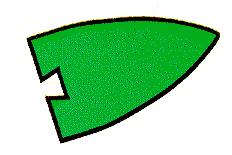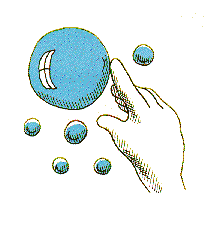SOAP POWER
Have you ever tried using soap to power a boat? This simple activity works because of "surface tension."
 What you'll need
What you'll need
1 index card
Scissors
A baking dish (or sink full of water)
Liquid dish detergent
Your science journal
What to do
- From an index card, cut out a boat like this. Make it about 2 1/2 inches long and 1 1/2 inches wide.
- Place the boat gently on the water in the dish.
- Pour a little detergent into the notch in the end of the boat. What happens? If you repeat the experiment, wash out the baking dish carefully each time you use detergent, or your boat won't go.
Your boat should zip across the water. Water molecules are strongly attracted to each other and stick close together, especially on the surface. This creates a strong but flexible "skin" on the water's surface that we call surface tension. Adding soap disrupts the arrangement of the water molecules and breaks the skin, making the boat go forward.
BUBBLES

Who doesn't enjoy blowing bubbles? You can make bubbles at home, and they can be beautiful shapes and colors!
What you'll need
8 tablespoons of dishwashing liquid
1 quart water
1 drinking straw
A shallow tray
Grown-up alert!
1 tin can, open at both ends
Your science journal
What to do
- Mix the dishwashing liquid with the water. Fill the shallow tray.
- Blow through your straw as you move it slowly across the surface of the solution. How big are the bubbles you get?
- Try making a very big bubble that covers the surface of the tray:
- Dip one end of the straw into the sudsy solution then hold the straw slightly above the surface of the solution. Blow into it very gently. You may have to try several times to make a really big bubble.
- When you have made a bubble, touch it gently with a wet finger. What happens?
- Make another big bubble. Touch this one with a dry finger. What happens?
- Try making bubbles with a tin can (don't cut yourself) open at both ends. Dip the can into the soapy solution so that you get a soap "window" across one end when you pull it out. Blow gently on the other end to form a bubble. You can use wider tubes such as coffee cans to make still bigger bubbles.
- Look closely at the bubbles you make. How many colors can you see? Do the colors change?
- If you have a wand at home that is left over from a bottle of bubbles you bought at the store, you can use it with this bubble solution.
Bubbles are bits of air or gas trapped inside a liquid ball. The surface of a bubble is very thin. Bubbles are particularly fragile when a dry object touches them. That's because soap film tends to stick to the object, which puts a strain on the bubble. So if you want your bubbles to last longer, keep everything wet, even the sides of the straw.